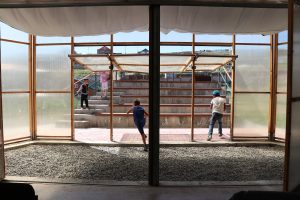Mongolia’s capital city is growing rapidly, and the influx of nomadic families to the outskirts of Ulaanbaatar is straining its already fragile infrastructure.
The lack of medical resources combined with astronomical levels of pollution and food insecurity pose a threat to all residents, but young children and pregnant women in particular.
Since 1990, the number of people living in urban areas in Mongolia has increased from 58 percent to nearly 70 percent. This number continues to grow each year as nomadic herders relocate to ger areas – recently settled areas in the hills and mountains surrounding Ulaanbaatar.
These areas lack essential resources like plumbing, electricity, and access to clean water and healthy food. Many residents choose to live in ger areas because their proximity to the city holds the promise of educational and career opportunities.
“It’s important to note that the ger area isn’t a ‘slum’ – it’s a very important part of the city,” said Daria Azbayar, a social innovation lead for GerHub, a nonprofit that works closely with residents of Songinokhairkhan, the fastest growing ger district in Ulaanbaatar. “Ulaanbaatar was a nomadic city – it moved around – so our original form of the city was ger areas.”
GerHub’s most visible contribution to Songinokhairkhan is the Ger Innovation Hub – a community center that seeks to bridge the infrastructural gaps that local residents face.
Designed to replicate the traditional structure of a ger, the Ger Innovation Hub’s architecture utilizes modern materials and is engineered to maximize energy efficiency by trapping heat within the walls.
Approximately half of Ulaanbaatar residents live in traditional gers – structures made of organic materials like wood and thick fabric. The Innovation Hub borrows structural elements of the ger design but substitutes cloth for polycarbonate sheets that can expand and contract in extreme temperatures without breaking.
The sheets also enable natural light to enter the space, minimizing the need for electricity.
Rural Urban Framework, Hong Kong University’s architecture design research center, designed the center to give the surrounding residents a space to gather and organize, and an opportunity to form a more permanent sense of community.
Integrating the community into GerHub’s Innovation Hub wasn’t an easy process. “There’s no word for ‘community’ in the Mongolian language,” said Azbayar. She said residents were initially reluctant to participate in events hosted by the center when it opened up in March 2022.
“In ger areas, people tend to be very separated from each other. You have your own plots with fences around them,” said Azbayar. “When we opened up the space, we could hear crickets.”
According to Azbayar, while residents of the ger district face challenges, they also have new opportunities and a growing sense of unity – positive outlooks that GerHub seeks to facilitate through programming that provides education and community building activities.
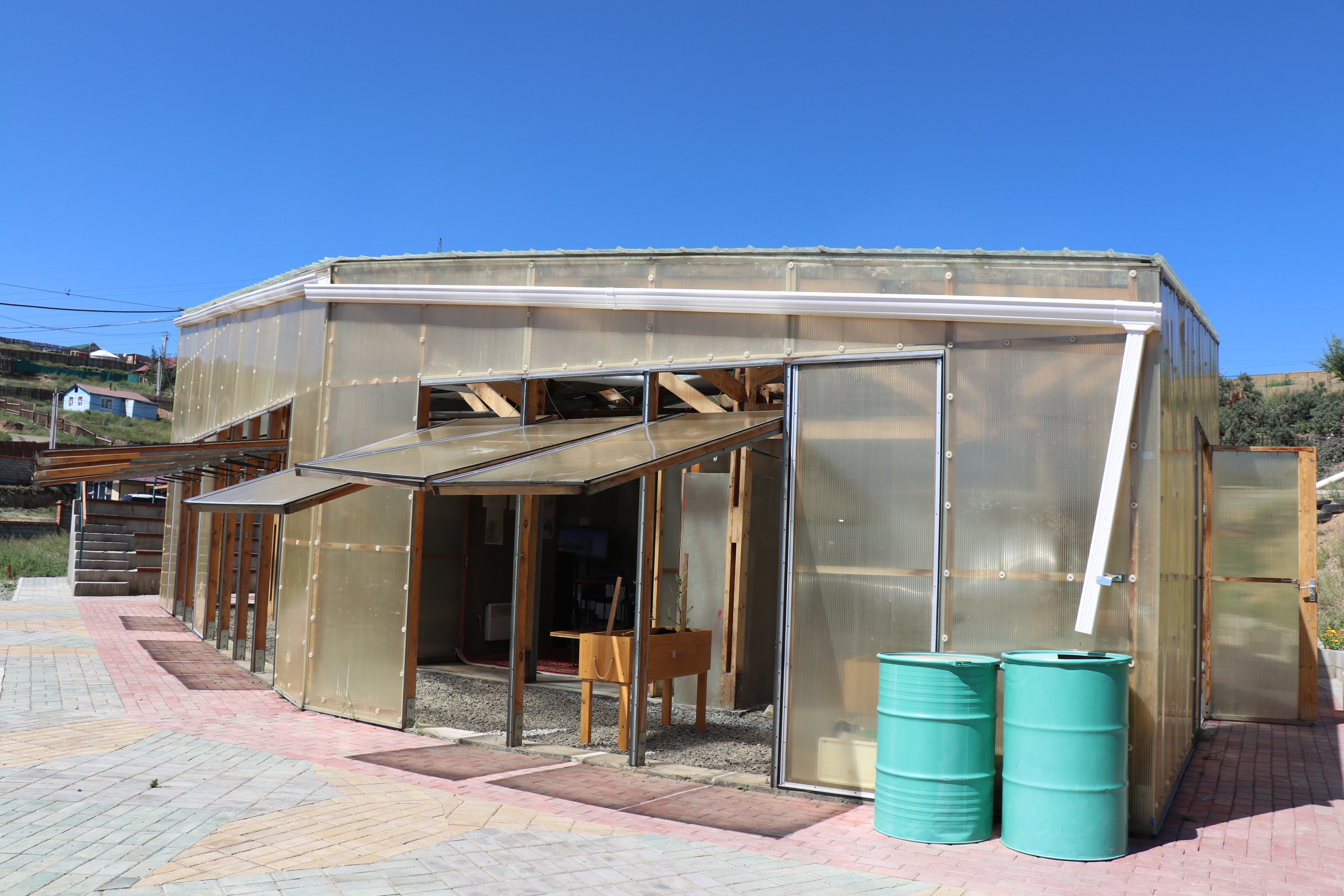
Designed to serve as a permanent component of a community that primarily lives in mobile housing, the Ger Innovation Hub provides essential resources to a community that lacks electricity, sanitation, plumbing, schools and play spaces for children. Photo by Katie Schulder-Battis, 2023.
Air Pollution
Sambuu Urtnasan, who frequently visits the Ger Innovation Hub, has lived in Ulaanbaatar’s Songinokhairkhan District for more than 25 years, and originally moved there seeking job opportunities.
“One of the biggest challenges is the winter season,” said Urtnasan. “It is hard to walk in the streets especially due to the steep topography in my neighborhood. But the topography is an advantage when it comes to the terrible air pollution – you have more airflow.”
During the freezing winter months, Ulaanbaatar is often ranked one of the most polluted cities on the planet, and this pollution is particularly concentrated in ger districts where residents burn coal to stay warm.
According to UNICEF, nearly 90 percent of energy consumed in Mongolia is used for heating purposes, and coal is the primary energy source. Pollution soars on the coldest days, with records of particulate matter in Ulaanbaatar reaching up to 133 times the World Health Organization (WHO) guidelines’ mean for pollution.
The high levels of pollution result in negative health outcomes, including higher rates of infant mortality and dysfunctional births as well as severe respiratory diseases, which disproportionately affect children.
According to a UNICEF study, approximately 300 people die annually from pollution-related illnesses in Mongolia, 80 percent of whom are children.
Khishigjargal Batjantsan, UNICEF Mongolia’s program officer for Climate Change and Clean Air, says that one of the greatest obstacles in combatting air pollution has been a lack of data.
UNICEF has been leading efforts to study pollution in urban centers around Mongolia through the use of air quality monitors to gauge the levels of particulate matter on a local level.
“Over the last four or five years we’ve focused mainly on data generation,” said Batjantsan. “If we cannot measure, we cannot manage.”
In order to generate more specific data, UNICEF outfitted schools in high-risk areas with basic, low-cost air monitors. By working with the government, UNICEF also developed a forecasting model to predict levels of air pollution several days in advance.
UNICEF has produced data that national ministries and institutes use to guide public policy, and has worked with Bat-Erdene Bat-Ulzii, Mongolia’s minister of environment and tourism, to champion economic policies that incentivize investing in the transition from coal to green energy in households.
UNICEF’s Cooking, Heating and Insulations Products (CHIP) package is designed to provide “green loans” – government subsidized loans that are accessible through commercial banks – to enable residents to replace coal burning stoves with electric heating and battery-powered alternatives. The package also provides insulation products to reduce heat loss in gers.
The package has been used to provide green energy to over 2,000 households, reducing coal use by approximately four tons of coal per year for each household.
Applicants who meet credit requirements for green loans are advanced 20 percent of the cost of the CHIP package. But the package’s market price – approximately $900 – is still too high for many in the ger areas to afford.
“Air pollution is very seasonal, which also makes people very reluctant to invest in it,” said Ariunzaya Davaa, UNICEF Mongolia’s communication specialist. “People buy these products and then sell them back in the summer because they need the money.”
And according to Davaa, many families are simply unaware of the long-term health effects of air pollution.
“That’s why we also have to increase awareness of the health impacts, and to improve the health services,” Davaa said.
GerHub launched an initiative in partnership with University of Pennsylvania’s Center for Environmental Building and Design aimed at reducing pollution by creating guidelines for people to weatherize their gers with insulation materials to conserve heat and energy.
The program, called “Dulaan Ger,” which translates to “A Warm Ger,” also facilitates job opportunities for local community members to earn income by producing insulation materials.
“The Mongolian government tries to implement all sorts of very big scale anti-pollution initiatives,” said Azbayar. “But we believe that small steps, like properly insulating a ger, can help reduce air pollution.”
The Ger Innovation Hub also stands in the center of the community to show the community what sustainability looks like.
“We heat the space with electrical heaters in the winter to show our community members that an alternative heating system to coal exists,” said Azbayar. “We have shields on the roof in the summer to reflect back the sun – otherwise it gets super hot in here, which proves to us the building is doing its job.”
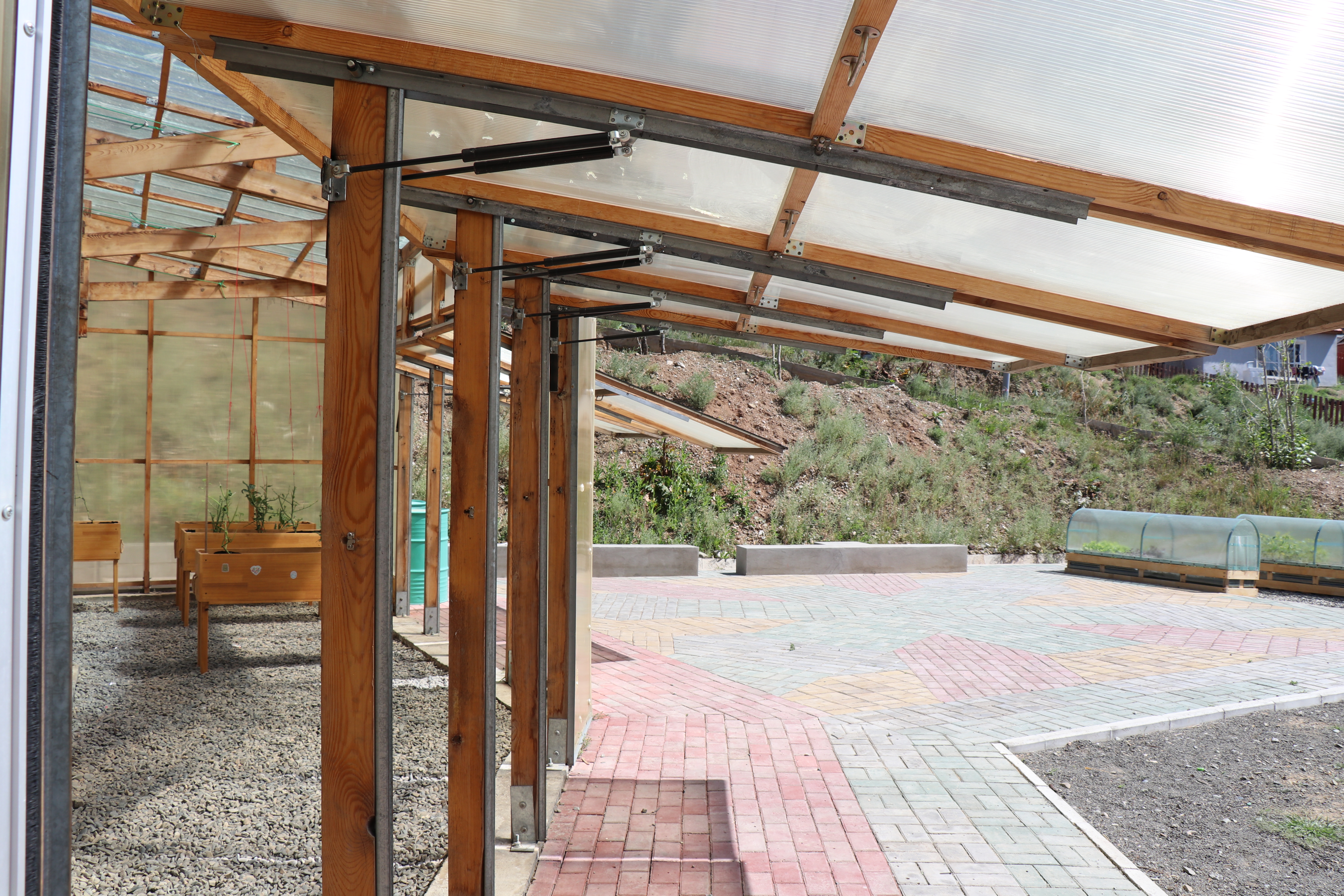
The Ger Innovation Hub was built between 2018 and 2020, using an architectural design that borrows elements of traditional cylindrical gers. Photo by Katie Schulder-Battis, 2023.
The Food Desert
In addition to pollution, health problems in Mongolia are closely associated with food insecurity and lack of access to nutritional foods.
In Ulaanbaatar, 68 percent of households are food insecure. Those living in ger districts face the greatest barriers to food security, including higher rates of unemployment, lower income, lack of available resources, and few methods of transportation.
Meat, dairy products, and animal fats are staples of a traditional diet among nomadic herders, whose primary forms of sustenance come from animals including sheep, yaks, horses, and cows. Traditional herders get an estimated one-third of their daily calories from dairy products alone.
But urban ger settlements offer little space for animals to graze, so herders who migrate to the outskirts of cities are left with few options.
Fresh produce is often prohibitively expensive in Mongolia, as most fruits and vegetables are imported due to the country’s short growth season, high altitude, and extreme fluctuation in temperatures.
Mongolia ranks in the bottom 10 percent of countries in production of fruit, fish and seafood, and oil crops, and Mongolia has the smallest fraction of arable utilized for permanent crops of any country.
“Ger areas are also very prone to becoming food deserts,” said Azbayar. “We don’t get to eat fresh produce during the cold half of the year and there aren’t a lot of good quality supermarkets in the ger areas, but they have the opportunity to grow and store things.”
When residents of ger areas are unable to find healthy food, they are forced to resort to options with poor nutritional value.
The impacts of consuming unhealthy foods can be seen in the disproportionate rates of type II diabetes and cardiovascular disease – which alone accounts for 37 percent of deaths in Mongolia. As of 2016, Mongolia had one of the highest rates of diet-preventable cardiovascular deaths in the world.
The average life expectancy in Mongolia is only 70 years, compared to 78 years in neighboring China and 84 in Japan.
GerHub recently began hosting a series of farming and gardening workshops to teach community members how to sow seeds and cultivate plants – knowledge that they hope can be used to provide healthy food for residents in the future.
GerHub’s horticulture workshop features compost bins and rainwater collection storage, and community participants are given seeds and gardening equipment.
“Although we have a very short growth season, people who live in the ger area have a piece of their own land that they can tend to,” said Azbayar.
Since joining GerHub’s horticulture program, Sambuu Urtnasan has started using his plot of land to grow tomatoes, cucumbers and other vegetables.
“I learned how to germinate seeds, take care of seedlings to grow different kinds of vegetables,” said Urtnasan. “I also got the idea of using scrap materials to build a DIY greenhouse. I met many of my neighbors and interacted with many children of the area, and it brings me lots of joy to see them learn and grow.”
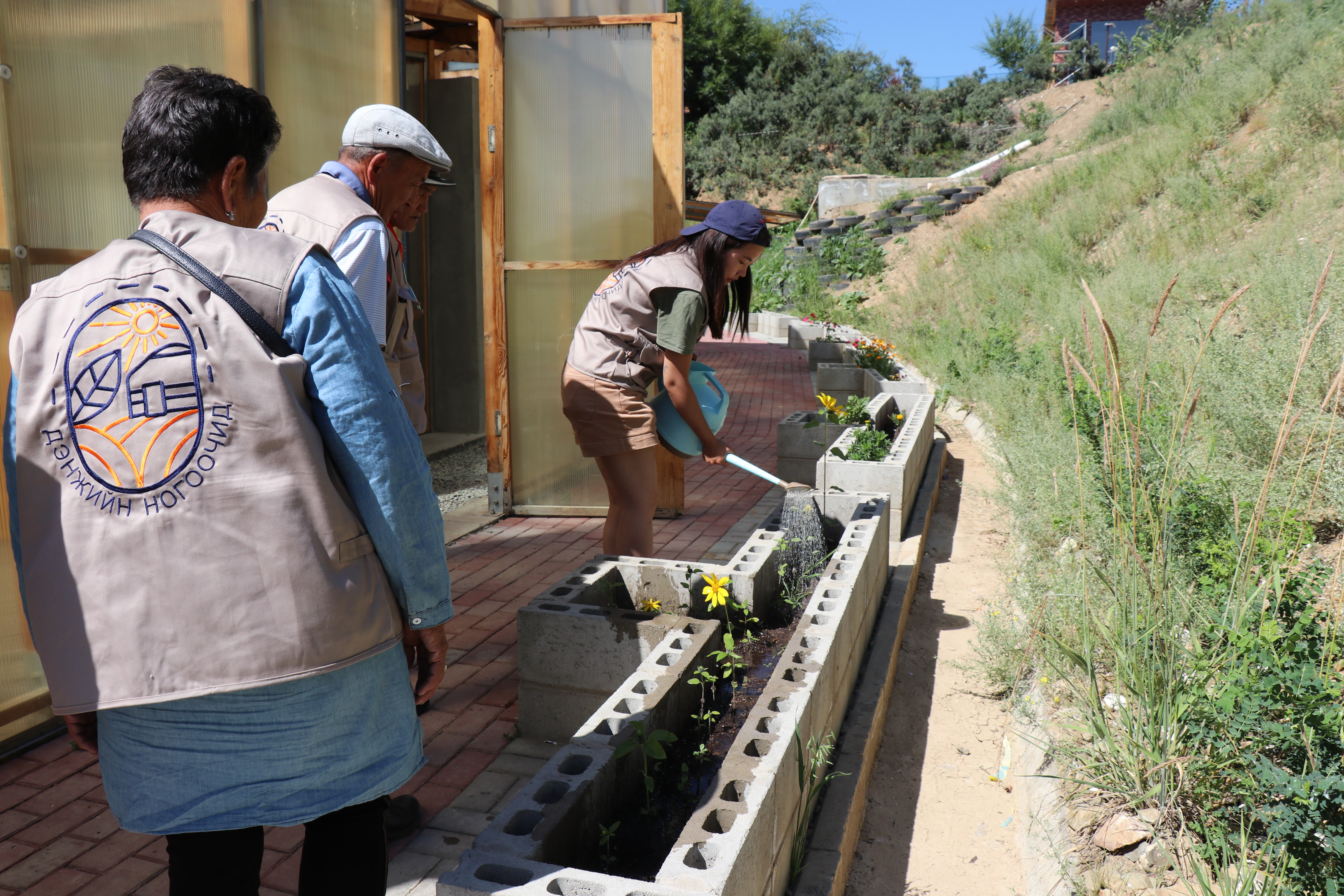
GerHub recently launched a horticulture and gardening club. Photo by Katie Schulder-Battis, 2023.
Healthcare
In addition to increasing access to food, GerHub has also teamed up with other nonprofits to make medical resources more readily available.
With the help of Public Lab Mongolia, an environmental justice nonprofit with a focus on open source data, GerHub launched an investigation into barriers that prevented the distribution of medical resources during COVID-19. Because ger areas often represent data blindspots, the project sought to evaluate the factors that prevented people from accessing resources and pave the way for innovative solutions.
“We have new settlers who live on top of hills because we have land developability challenges,” said Uurtsaikh Sangi, GerHub’s CEO. Although they live on the periphery of the country’s capital city, the project revealed that residents of the ger district were located in areas that were inaccessible for nurses who were already burdened with heavy caseloads.
The project used taxis to deliver medicine around the ger district using a no-contact system, relieving the strain on medical professionals while gathering data on the geography of the district.
In spite of the many challenges that residents face, many have made the ger district a permanent home. As populations continue to grow, community partnerships with nonprofits will become even more important.
Residents like Sambuu Urtnasan, who appreciates the impact that having a community gathering space has had on his life, remain optimistic.
“Everyone is putting in a lot of effort to create a good life for themselves,” Sambuu said. “I met many of my neighbors and interacted with many children of the area, and it brings me lots of joy to see them learn and grow.”
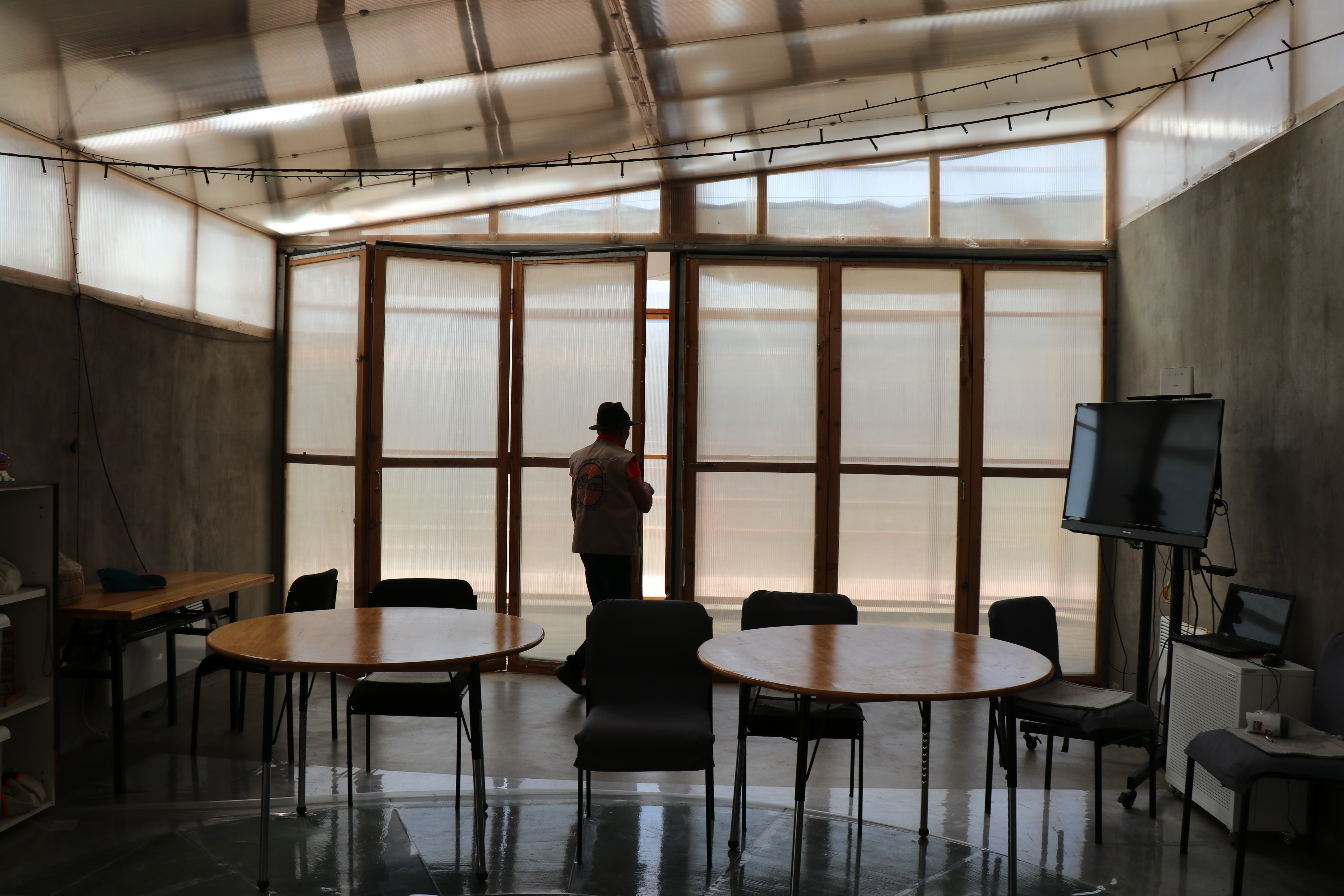
Accordion-style doors can be opened and closed to maintain a comfortable temperature in the Hub. Photo by Katie Schulder-Battis, 2023.
The reporting of this story was made possible by a reporting fellowship from the Pulitzer Center.













